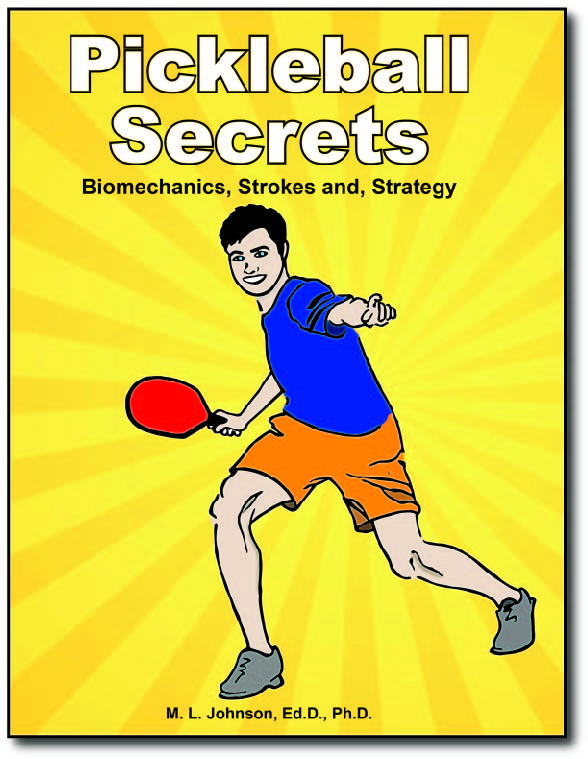Academic, Professional, Technical, Trade, Research Books & Journals
americanpress@flash.net • 617-247-0022 • 75 State Street #100 • Boston, MA 02109
Pickleball Secrets
Biomechanics, Strokes, and StrategyM.L. JOHNSON
July 2021, 138 pags
Cover design by White Space Graphics, Janell Osborn
Illustrations by M.L. Johnson
ISBN 978-0-89641-615-4
$24.95 (includes shipping)
Pickleball is a fun athletic and social activity. Pickleball Secrets: Biomechanics, Strokes, and Strategy was written to introduce more sport science to the game. Individuals can certainly perform at a very high level without knowledge of biomechanics. But, when players understand the underlying science, they can become their own coach. Hints and error corrections are noticeably absent from the book, as focus should be on learning effective stroking rather than trying to fix fundamentally ineffective stroke mechanics. The book is also a source of verbiage for coaches to both describe biomechanics of the respective stokes and identify muscle groups that need strengthening. Research into game strategy and management of emotions during competition are included.
With more active seniors and pickleball being introduced in schools, participation has grown geometrically. Pickleball was added to the annual Colorado Senior Games and that grew from a one-day event to multiple days—including some rather young and intense seniors. The scene has now changed from hoping to find a fourth player to hoping to find court space.
We now know that those who play racket sports tend to live longer than the non-exercisers. Two longitudinal studies, one including 80,000 and the other of 8,600 women and men, found that, compared to the sedentary, jogging/biking added 3.2 years and tennis added 9.7 years of longevity. These findings held up even when controlled for people’s age, education, and socioeconomic status. Explanations vary, but these studies show that frequently raising your heart rate is important, but connecting with other people during exercise is even more important. Interactive exercise with a partner or team apparently has beneficial psychological and physiological effects.
Given that pickleball has such a brief history, and biomechanics research has not caught up with its popularity, it is necessary to cite parallel research studies—particularly those conducted in tennis and badminton. Extensive experience in squash rackets, racquetball, tennis, badminton, and pickleball, helps in selecting which studies reasonable apply to pickleball.
CONTENTS
Chapter 1: INTRODUCTION
The Game
Equipment and facilities
Sstrokes and shots
Basic rules
Getting started
Getting better
Terms
Timeline of eventsChapter 2: BIOMECHANICS
Performance factors
Biomechanics applications
Fundamental piositions and angles
Sport scienceChapter 3: SERVING
Serve
Serve Return
Key pointsChapter 4: FOREHAND GROUNDSTROKE
Flaat drive
Topspin forehand drive
Slice/backhand stroke
Key points
Sports scienceChapter 5: BACKHAND GROUNDSTROKE
Flat stroke
Topspin stroke
Spin/slice stroke
Key pointsChapter 6: FOREHAND VOLLEY STROKES
Volley stroke
Half volley stroke
Key pointsChapter 7: BACKHAND VOLLEY STROKES
Backhand volley stroke
Backhand half-volley stroke
Key points
Sport scienceChapter 8: FOREHAND AND BACKHAND SOFT STROKES
Types of soft strokes
Forehand soft strokes
Backhand soft strokes
Key pointsChapter 9: OVERHEAD STROKES
High forehand volley
High backhand volley
Forehand smash
Backhand overhead smash
Sports scienceChapter 10: LOB STROKES
Forehand lob stroke
Backhand lob stroke
Key pointsChapter 11: SINGLES STRATEGY
Strategy Theory
Operationalizing strategy
Key points
WarmupChapter 12: DOUBLES AND MIXED DOUBLES STRATEGY
Partners
Strategy decision process
Your turn
Player positioning
Key pointsChapter 13: SPORT PSYCHOLOGY
Stages in skill acquisition
Factor effets over time
The practice effects
Transfer of training
Motivation
Attribution
Anxiety management
Managing performnce anxiety
Playing benefitsRESOURCES
REFERENCES
ABOUT THE AUTHOR . . .
M.L. Johnson, Ed.D., Ph.D. is a professional educator and university administrator, is an author of 18 books—with titles ranging from sport program management and sport instruction to business entrepreneurism. He is listed in “Who’s Who in American Education, “Who’s Who in Louisiana,” and “Outstanding Young Men of America.” His instructional video program, produced by contract with theU.S. Department of Education, won a Silver CINDY Award and a Videographer of Distinction Award. He is a Fellow of the Bighorn Center for Public Policy and a Colorado State University emeritus professor. As a lifelong multi-sport participant, he won the Dallas Open Men’s Doubles Badminton Tournament with Tan Joe Hok, numerous regional Men’s Doubles and Mixed Doubles tennis tournaments, numerous State Senior Games Pickleball Doubles and Mixed Doubles Medals, and State Senior Games Singles and Men’s Doubles Racquetball titles.